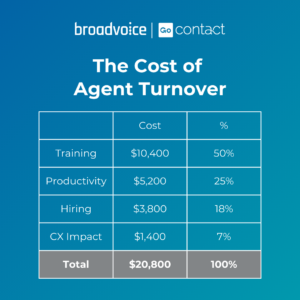Let’s cut to the chase: your agents are quitting. A lot. In fact, the average turnover for a contact center hovers between 30-45%. With that kind of loss, how will you ever have a steady collective of agents who fully know and understand your products and services? How are you ever going to develop institutional knowledge?
And it’s not just an inconvenience, but it’s expensive, too. Replacing an agent can cost your center anywhere between $5K-$25K, when factoring in hiring, training, and lost productivity during ramp. What that number misses, though, is the tax it adds to other agents’ plates and the expense of the impact it has on your role as a manager. Think about it, if you’re searching for a new hire, you’re not coaching and developing your agents. And you’re not taking escalations. And you’re leaning on high performers to pick up your slack until they ultimately burn out. It’s a vicious, losing cycle.
The question is: How do you keep your best agents from walking out the door?
This guide breaks down real-world, actionable strategies to reduce turnover, boost engagement, and create an environment where employees want to stay.
Why Agents Leave
If you don’t understand why agents leave, you won’t be able to stop the churn. Contact centers operate under intense pressure, and without the right structure, leadership, and incentives, employees quickly burn out or seek better opportunities elsewhere.
The Top Reasons Agents Quit (And What You Can Do About It)
Burnout Makes Them Crash Out
Unrealistic KPIs, back-to-back customer interactions, and handling frustrated callers all day take a toll. Agents don’t just deal with customer problems—they absorb stress from every conversation. Over time, this leads to exhaustion, disengagement, and eventually resignation.
What You Can Do:
- Rethink KPIs. Ensure they balance efficiency with agent well-being.
- Encourage real breaks. Enforce time away from screens and high-stress interactions.
- Provide wellness resources. Mental health support, wellness stipends, and stress management tools can make a significant difference.
There’s a Serious Lack of Career Growth
Many agents view contact center jobs as a steppingstone, not a career path. If employees don’t see opportunities to develop their skills or advance, they’ll move on to roles with clearer growth potential.
What You Can Do:
- Establish clear career pathways for advancement.
- Offer mentorship programs to connect junior agents with experienced leaders.
- Invest in ongoing training to help agents build new skills and move up internally.
A Toxic Culture is Creating Resentment
A high-pressure environment is one thing, but a toxic workplace accelerates turnover. Poor management, micromanagement, and unchecked negativity from employees can destroy morale.
What You Can Do:
- Train managers in effective leadership and communication skills.
- Address toxic employees—even if they perform well on paper, they can be damaging to the overall team.
- Foster a culture of respect, support, and transparency.
Proven Employee Retention Strategies to Add in Your Contact Center
Retention Starts at Onboarding
Retention issues often begin at the very start of employment. A poorly structured onboarding process can leave new hires feeling lost, unprepared, and disengaged within weeks.
How to Build an Effective Onboarding Program:
- Structure training around real-world scenarios. Instead of overwhelming new hires with policies and decks, integrate interactive learning sessions with real examples from customer interactions.
- Showcase top-performing agents. Let them share their insights, helping new hires visualize success.
- Implement an onboarding buddy system. Pairing new hires with experienced agents helps them feel supported from day one.
- Include critical knowledge areas. Ensure onboarding covers product knowledge, customer personas, and access to eLearning courses to support continued learning.
A well-designed onboarding program reduces early turnover and increases agent confidence, setting them up for long-term success.
Take a Serious Look at Compensation
Retention issues often boil down to compensation. Many agents will leave for even a small pay increase elsewhere.
While increasing salaries across the board may not be realistic, there are alternative ways to make compensation more competitive.
What You Can Do:
- Introduce performance-based bonuses. Reward agents for exceeding customer satisfaction metrics and achieving quality benchmarks.
- Provide non-monetary incentives. Consider benefits like additional PTO, wellness stipends, and flexible scheduling.
- Reevaluate pay structures regularly. Benchmark salaries against competitors to ensure your compensation remains attractive.
Low pay often leads to low engagement, lower-quality service, and ultimately, higher turnover. Retention starts with ensuring employees feel fairly compensated for their work.
Create a Path for Career Growth and Upskilling
If you want agents to stay, they need to see a future in your company.
Internal mobility doesn’t just boost morale, it also reduces hiring costs by filling leadership roles with people who already understand the business.
What You Can Do:
- Promote from within. Make internal career progression a priority.
- Offer mentorship programs. Pair agents with senior team members who can guide them toward growth opportunities.
- Invest in ongoing training. Short, targeted learning opportunities (microlearning) help agents build skills while still on the job.
When employees see a clear development path, they’re more likely to stay invested in their work.
Build a Culture Agents Want to Stay In
Engagement isn’t just about perks—it’s about creating an environment where agents feel valued and motivated.
What You Can Do:
- Use gamification. Recognition programs, contests, and leaderboards make work more interactive and rewarding.
- Establish a continuous feedback loop. Frequent check-ins allow employees to voice concerns before they escalate into major issues.
- Create a psychologically safe workplace. Employees should feel comfortable bringing up challenges and asking for support without fear of retaliation.
Culture plays a critical role in long-term retention. A positive, supportive environment reduces stress, increases loyalty, and improves overall performance.
The Tools & Tech That Support Retention
Use AI and Automation to Reduce Agent Stress
Technology can help alleviate some of the pressure agents face daily.
How AI Helps:
- Self-service options offload repetitive inquiries to chatbots and knowledge bases.
- Agent Assist tools provide real-time recommendations, reducing the cognitive load during interactions.
- Workflow automation eliminates tedious manual tasks, allowing agents to focus on complex issues.
By adding AI-driven tools, contact centers can improve efficiency and create a more manageable workload for agents.
Workforce Management and Scheduling Should Support Work-Life Balance
Rigid and unpredictable schedules are a major driver of burnout.
How to Improve Scheduling for Retention:
- Use predictive scheduling to optimize staffing levels without overworking employees.
- Allow shift swaps without red tape. Empower agents to manage their schedules through self-service tools.
- Implement flexible scheduling where possible. Even small adjustments can improve work-life balance.
Better scheduling isn’t just good for retention—it also improves overall operational efficiency.
See Workforce Management in action.
Bonus: Your Quick-Start Checklist for Employee Retention
- Improve onboarding to create early engagement.
- Review compensation to remain competitive.
- Find creative, low-cost incentives to retain agents.
- Establish career development programs to encourage long-term growth.
- Create a structured feedback process to capture employee concerns before they escalate.
- Use AI and automation to reduce workload stress.
- Optimize scheduling practices to promote work-life balance.
- Actively seek employee feedback to refine your retention strategies.
Employee retention is not a one-time fix. It’s an ongoing process that requires consistent evaluation and improvement.
Start by implementing one strategy from this guide over the next month. Track the impact, refine as needed, and expand from there.
Because when you invest in your agents, they invest in your customers—and that’s how you build a thriving contact center.













